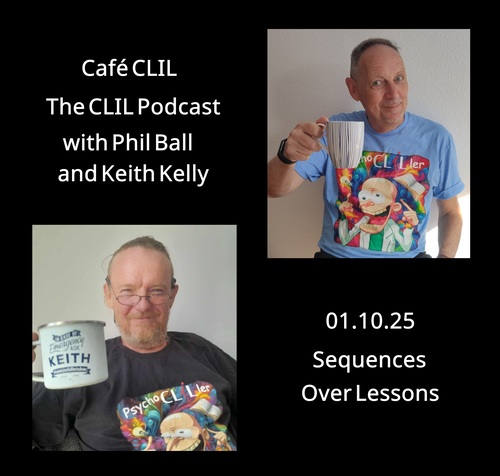RESOURCES

Cafe CLIL - Sequencing Over Lessons (251001)
Cafe CLIL - Sequencing Over Lessons (251001)Audio file of the recording
CLIL Sequencing Discussion
Keith and Phil agreed to focus on sequencing in CLIL, which Phil emphasized as a natural and important aspect of the three dimensions of CLIL, referencing their book's seven characteristics of CLIL, where conceptual sequencing was highlighted as a key feature.
Integrating CLIL for Sequenced Learning
Phil expressed concerns about the prevalence of downloadable CLIL lessons, particularly those focused on single topics like the water cycle, which he believes do not align with the epistemological truth that knowledge is acquired through sequences rather than isolated lessons. He emphasized that a science teacher would approach the water cycle as part of a longer sequence, not a single lesson, and highlighted the linguistic implications of this approach. Keith agreed with Phil's concerns, noting the challenge of conveying this perspective to publishers and the need for a more integrated approach to CLIL within the language curriculum.
Empowering Learners Through Integrated Curriculum
Keith and Phil discussed the importance of empowering learners with knowledge and the difference in perspective between language teachers and subject teachers, particularly in integrated lessons and STEAM education. Keith explained how his school organizes learning experiences for full-day students by aligning the language curriculum with the Bulgarian national curriculum, focusing on concepts and procedures. They agreed that project-based learning (PBL) is an effective approach for young learners, as it helps maintain continuity and build on previous knowledge, which is particularly advantageous in a full-day learning environment.
Teaching Dynamics and Narrative Structure
Keith and Phil discussed the dynamics of teaching, particularly focusing on the structure of lessons and how they can be applied to different teaching methods. Phil introduced the concept of narrative structure in teaching, which includes an orientation, complication, and resolution period. They explored how this structure can be extended over a sequence of lessons and how it applies to both subject and language teaching. Keith shared insights from his experience with full-day and evening language classes, highlighting the importance of the resolution stage for younger learners and the opportunity for repetition of meaningful language. Phil and Keith agreed on the value of understanding these teaching dynamics to enhance language learning in CLIL environments.
Language Progression in Education
Phil and Keith discussed the progression of language use in education, particularly in the context of teaching subjects like ‘communism’ in secondary school. They emphasized that language teachers should be aware of different stages in learning, including an orientation phase where language is simpler, and a resolution phase where more academic language is expected. Keith suggested that teachers across subjects should have an understanding of the broader curriculum to better support language learning and make connections between different subjects.
Engaging Learners Through Thinking Curriculum
Keith and Phil discussed the teaching approach used in David Leat's "Thinking Through Geography" series, which begins with small group brainstorms and incorporates various resources for learning. They explored the concept of a thinking curriculum and the importance of engaging learners through curiosity. Phil emphasized the need to examine how language teaching incorporates these stages conceptually and mentioned Neil Mercer's work on classroom dialogue, comparing it to the orientation, complication, and resolution stages of a lesson.
Cumulative Language in Education
Phil and Keith discussed the importance of cumulative language in education, particularly in CLIL. They explored how extending language sequences and incorporating exploratory, disputational, and cumulative language can enhance linguistic experiences. Keith shared challenges faced in his school due to unpredictable student retention and the need for a cyclical approach to complex concepts. They also discussed the natural variation in how students acquire language, including silent periods, and emphasized the importance of allowing meaningful engagement and fun in language learning.
Curriculum Alignment for Sustainable Goals
Keith and Phil discussed the importance of creating educational resources to align with curriculum guidelines, particularly for teaching about UNSDGs. Keith shared his plans to work with Italian teachers on developing materials for young children, focusing on themes like mutual respect, care for the community, and care for the environment. Phil emphasized the significance of designing "safe activities" during the orientation period to ensure conceptual and linguistic safety for students. They agreed to continue their discussion on aligning the language curriculum with other parts of the curriculum in their next meeting.